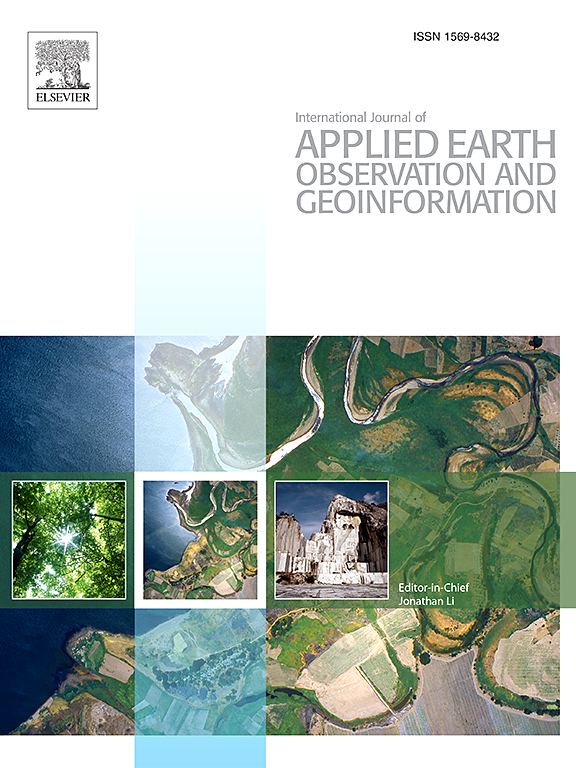Extraction of built-up areas using Sentinel-1 and Sentinel-2 data with automated training data sampling and label noise robust cross-fusion neural networks
IF 7.6
Q1 REMOTE SENSING
International journal of applied earth observation and geoinformation : ITC journal
Pub Date : 2025-04-14
DOI:10.1016/j.jag.2025.104524
引用次数: 0
Abstract
Up-to-date mapping of built-up areas is of paramount importance for urban planning, environmental monitoring, and disaster management. In recent years, there has been a growing interest in employing supervised machine learning and deep learning methods to map built-up areas using satellite SAR and optical data. However, the laborious and expensive task of gathering and maintaining a vast array of diverse training data poses a challenge to the widespread adoption of these methods for large-scale built-up area mapping. This paper presents a two-step framework enabling an automated extraction of built-up areas using Sentinel-1 and Sentinel-2 data. Initially, training data for built-up and non-built-up classes are automatically sampled and labeled from Sentinel-1 and Sentinel-2 data for a given area of interest. Subsequently, a cross-fusion neural network is trained using the samples from the first step to produce a built-up map for the entire study area. To enhance the network’s resilience to label noise, a contextual virtual adversarial training (CVAT) regularization is introduced within the mean-teacher architecture. Our proposed framework was tested on 48 different study areas across the world. Both quantitative and qualitative evaluations demonstrate its robustness and effectiveness for large-scale built-up area extraction. The versatility of our framework in generating accurate and up-to-date built-up information, which is essential for monitoring urban environments and assessing economic losses resulting from natural disasters, is highlighted through comparisons with four state-of-the-art global built-up products: Global Human Settlement Built-up map based on 2018 Sentinel-2 composites (GHS-BUILT-S2), World Settlement Footprint 2019 (WSF 2019), ESA World Cover, and Dynamic World.
利用哨兵 1 号和哨兵 2 号数据,通过自动训练数据采样和标签噪声稳健交叉融合神经网络,提取建筑密集区的数据
建成区的最新制图对于城市规划、环境监测和灾害管理至关重要。近年来,人们对使用监督机器学习和深度学习方法利用卫星SAR和光学数据绘制建成区的兴趣越来越大。然而,收集和维护大量不同的训练数据是一项费力而昂贵的任务,这对这些方法在大规模建成区制图中的广泛采用提出了挑战。本文提出了一个两步框架,可以使用Sentinel-1和Sentinel-2数据自动提取建成区。最初,针对给定的兴趣区域,从Sentinel-1和Sentinel-2数据中自动采样和标记已构建和未构建类的训练数据。随后,使用第一步的样本训练交叉融合神经网络,生成整个研究区域的建筑地图。为了增强网络对标签噪声的适应能力,在平均教师体系结构中引入了上下文虚拟对抗训练(CVAT)正则化。我们提出的框架在全球48个不同的研究领域进行了测试。定量和定性评价均证明了该方法对大规模建成区提取的鲁棒性和有效性。我们的框架在生成准确和最新的建筑信息方面的多功能性,对于监测城市环境和评估自然灾害造成的经济损失至关重要,通过与四种最先进的全球建筑产品进行比较,突出了这一框架的多功能性:基于2018年Sentinel-2复合材料的全球人类住区建筑地图(GHS-BUILT-S2)、2019年世界住区足迹(WSF 2019)、欧洲空间局世界覆盖和动态世界。
本文章由计算机程序翻译,如有差异,请以英文原文为准。
求助全文
约1分钟内获得全文
求助全文
来源期刊

International journal of applied earth observation and geoinformation : ITC journal
Global and Planetary Change, Management, Monitoring, Policy and Law, Earth-Surface Processes, Computers in Earth Sciences
CiteScore
12.00
自引率
0.00%
发文量
0
审稿时长
77 days
期刊介绍:
The International Journal of Applied Earth Observation and Geoinformation publishes original papers that utilize earth observation data for natural resource and environmental inventory and management. These data primarily originate from remote sensing platforms, including satellites and aircraft, supplemented by surface and subsurface measurements. Addressing natural resources such as forests, agricultural land, soils, and water, as well as environmental concerns like biodiversity, land degradation, and hazards, the journal explores conceptual and data-driven approaches. It covers geoinformation themes like capturing, databasing, visualization, interpretation, data quality, and spatial uncertainty.
 求助内容:
求助内容: 应助结果提醒方式:
应助结果提醒方式:


